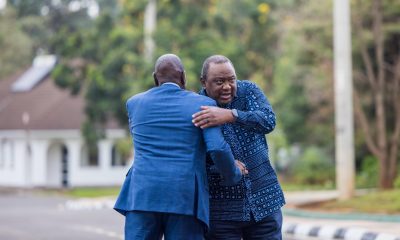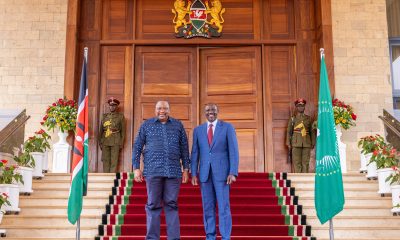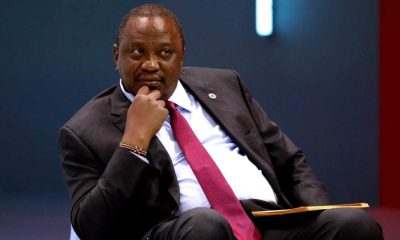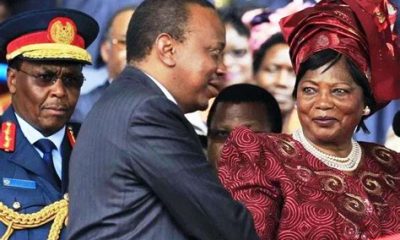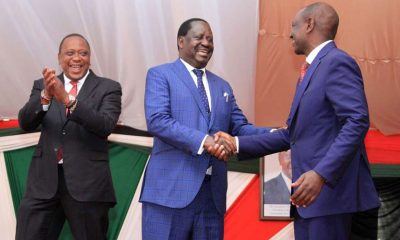Politics
President Uhuru Kenyatta Rise to Glory Coincided With Rise of Mungiki; New York Times Rattles Statehouse

New York Times’ James Verini did a month’s long investigated story looking into how International Criminal Court (ICC) embodied the hope of bringing warlords and demagogues to justice. The story then goes to see how the then Prosecutor Luis Moreno-Ocampo took on the heir to Kenya’s most powerful political dynasty. The article, which has since gone viral, is causing stomach upsets amongst those severely mentioned. President Kenyatta has bashed the magazine for being inconsiderate terming the publication a falsehood and done in bad faith.
President Kenyatta from the onset has been a fierce critic of the court where he was charged alongside the famous Ocampo six for crimes against humanity. All the suspects have since been exonerated with the last defendants to escape noose being his counterpart in Jubilee government Deputy President William Ruto and radio presenter Joshua Sang.
Uhuru Kenyatta’s rise coincided with the rise of Mungiki, the group Moreno-Ocampo would later accuse him of conspiring with in the post-election violence, writes James Verini. Started as a tribal revivalist movement, Mungiki grew into a militaristic political fraternity and then into a criminal gang. Around the time Mungiki fought to take over the lucrative private bus lines that are the primary form of transport in Kenya, in the early 2000s, the gang staged a massacre in northern Nairobi that left severed heads scattered in the streets.
By then, Mungiki was being described as a “state within a state,” with up to two million members, according to reports. They swore an oath of loyalty to the Kikuyu tribe and the Mungiki leader, a charismatic, ruthless man known as Maina Njenga. According to the ICC, new recruits “were told they would be killed if they violated the oath or left the organisation.” When clashes broke out between Kikuyu and other tribes, Njenga dispatched his men to fight.
He also persuaded politicians to take the Mungiki oath. Paul Muite, a Member of Parliament at the time and now a lawyer who represents Njenga and other members of Mungiki, which is still active, told me that almost every Kikuyu politician of consequence he knew during that era took the oath. For Njenga, it was “a way of collecting” power, Muite says. According to Muite and a former lieutenant of Njenga’s with whom NY Times spoke to, one of the politicians who took the oath, before becoming president, was Kibaki.
Some Mungiki members, including Njenga, supported Kenyatta’s 2002 presidential campaign. Kenyatta denounced the group and would later tell Moreno-Ocampo in court that “I have always publicly condemned and stated that I have no association whatsoever with Mungiki.” Njenga’s former lieutenant, however, described to me a series of meetings he attended with Kenyatta and Njenga in 2002, saying that Kenyatta was friendly with Mungiki. But, he added, Kenyatta didn’t like or trust Njenga.
In the 2007 election, Kenyatta did not run, instead supporting Kibaki in his race against Raila Odinga. By the close of Election Day, two days after Christmas, the vote was too close to call. The count was delayed. The tally centre in Nairobi was mysteriously broken into. Then on Dec. 30, the government suddenly announced Kibaki had won. He was hurriedly sworn in, and a media blackout was imposed. Odinga instructed his followers to protest. By New Year’s Day, Kikuyu were being slaughtered. Mungiki began striking back in January.
The government did little to stop the post-election violence, but afterwards, it set up a commission of inquiry. Known as the Waki Commission, it issued a 529-page report in October 2008. The Kenya National Commission on Human Rights, an autonomous government agency, published a comparably exhaustive report.
Each was damning. Officials in Odinga’s party had planned violence months in advance, while envoys of President Kibaki met with Mungiki to plan retaliatory attacks. Security agents and the police had conspired with the gang. “There were no good guys,” a Waki commissioner, Pascal Kambale, told me. “There were only bad guys.”
Moreno-Ocampo, who monitored the violence as it was happening, travelled to Nairobi to speak with Kibaki. He encouraged Kibaki to refer Kenya to the ICC, as Congo and Uganda had made referrals. Government capacity wasn’t the problem, Moreno-Ocampo knew. Kenya was capable of trying the suspects.
The problem was as it had been in Argentina: The government was the criminal. And not only the government. The National Commission on Human Rights report listed more than 200 suspected inciters and funders of the violence, including presidential cabinet members, legislators, businessmen, shopkeepers, farmers. In a moment of collective insanity, Kenyan society had turned on itself.
Still, Moreno-Ocampo continued to press Kenyan officials to begin prosecutions. In 2009, the Kenyan Parliament voted against a tribunal — unsurprisingly, as the Parliament itself was full of suspects — and Moreno-Ocampo requested that the ICC judges allow him to open an investigation. They did. It was the first time he invoked his power to seek charges on his authority, without a referral.
In a part, the magazine reflects back to Kenyatta senior reign, After Jomo was freed and elected president of an independent Kenya in 1964, his revolutionary impulses didn’t persist. He stocked the government and businesses with family members and fellow Kikuyu.
The Waki report didn’t name Kenyatta, but the National Commission on Human Rights report did, saying that he reportedly “attended meetings to plan for retaliatory violence by the Kikuyus” and “contributed funds.” Kenyatta was considered by many Kikuyu, including many Mungiki, to be their leader, and was understood to be the richest man in the country. If anyone had the motivation and funds to back an ethnic war, Moreno-Ocampo’s investigators reasoned, it was Kenyatta.

Maina Njenga in company of CORD lEADER rAILA oDINGA SHOWING HIS WOUNDS AFTER A FAILED ASSASSINATION ATTEMPT ON HIS LIFE THAT LEFT HIS AIDES KILLED
The court considered charging Maina Njenga, the Mungiki sect Chairman. When Njenga was questioned by Kenyan investigators, he pleaded ignorance. But to the ICC investigators, he came clean. He detailed the structure of his organisation and its role in the violence. Njenga claimed to his lawyer, Paul Muite, that he had personally administered the Mungiki oath of loyalty to Kenyatta, though whether Njenga told this to ICC investigators is unclear. Njenga was “very forthright,” Muite told NY Times, and he later agreed to testify in The Hague.
In a punchy conclusion, the writer notes having spoken to a former Mungiki high ranked leader, like many Kenyans he was talking with, says he regrets the violence but believes it was necessary. The Kikuyu, his tribe, faced a massacre, he is convinced. The last time we met, I asked if he thought Kenyatta was guilty of the ICC charges.
He recounted a meeting he attended in January 2008, in the midst of the postelection violence, where Kenyatta was the chief guest and Mungiki were present. In the meeting, Kenyatta was careful never to mention violence explicitly nor the gang by name. But he collected cash donations. I asked the former lieutenant if it was possible Kenyatta did not understand violence was being planned.
“No,” he said, “it is not possible.”
I asked again.
“No,” he repeated. “With capital letters.”
Adapted from New York Times Magazine
Kenya Insights allows guest blogging, if you want to be published on Kenya’s most authoritative and accurate blog, have an expose, news TIPS, story angles, human interest stories, drop us an email on [email protected] or via Telegram
-
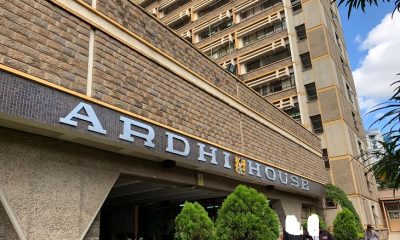
 Investigations2 weeks ago
Investigations2 weeks agoHow Land Grabbing Cartels Have Captured Ardhi House
-
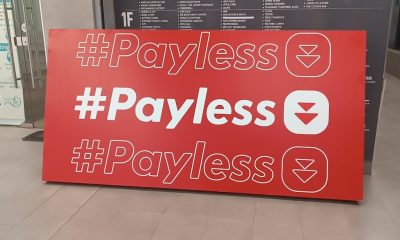
 Business2 weeks ago
Business2 weeks agoPanic As Payless Africa Freezes With Billions of Customers Cash After Costly Jambopay Blunder
-
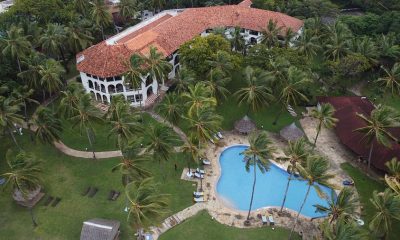
 News2 weeks ago
News2 weeks agoSCANDAL: Cocoa Luxury Resort Manager Returns to Post After Alleged Sh28 Million Bribe Clears Sexual Harassment and Racism Claims
-
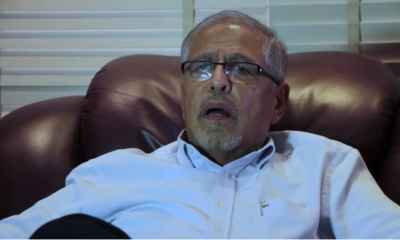
 News3 days ago
News3 days agoTemporary Reprieve As Mohamed Jaffer Wins Mombasa Land Compensation Despite Losing LPG Monopoly and Bitter Fallout With Johos
-
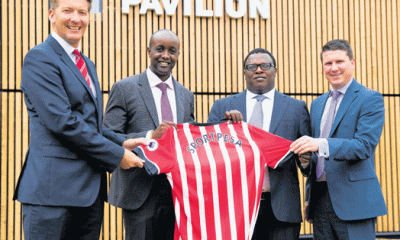
 Investigations1 week ago
Investigations1 week agoHow SportPesa Outfoxed Paul Ndung’u Of His Stakes With A Wrong Address Letter
-
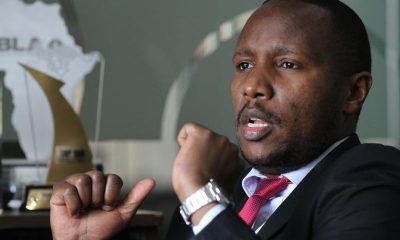
 Investigations3 days ago
Investigations3 days agoFrom Daily Bribes to Billions Frozen: The Jambopay Empire Crumbles as CEO Danson Muchemi’s Scandal-Plagued Past Catches Up
-
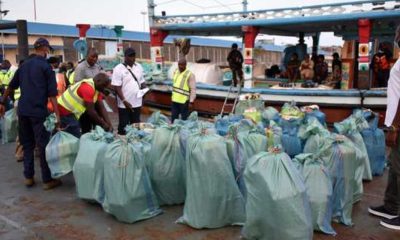
 Investigations2 weeks ago
Investigations2 weeks agoHow Arrest of a Soldier’s Spouse Dragged KDF Into Alleged Theft of Meth Haul in Mombasa
-
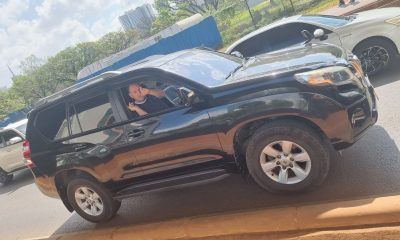
 News1 week ago
News1 week agoRentokil Boss Fraser Branch in Highway Smash as DUI and Racism Claims Surface








